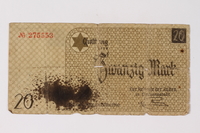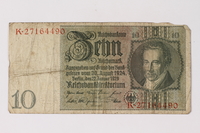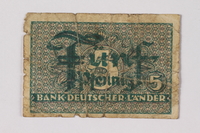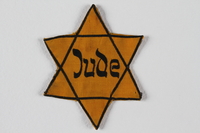Overview
- Description
- Mixed collection of black and white photographs, a postcard, an envelope, scrip, and a Star of David badge relating to Bella Tovey and her family during the time period of the Holocaust.
- Date
-
1941-1943
- Credit Line
- United States Holocaust Memorial Museum Collection, Gift of Bella Jakubowicz Tovey
Physical Details
- Genre/Form
- Stamped envelopes. Postcards. Photographs.
- Extent
-
1 folder
Rights & Restrictions
- Conditions on Access
- There are no known restrictions on access to this material.
- Conditions on Use
- Material(s) in this collection may be protected by copyright and/or related rights. You do not require further permission from the Museum to use this material. The user is solely responsible for making a determination as to if and how the material may be used.
Keywords & Subjects
- Topical Term
- Jewish ghettos--Poland--Sosnowiec. Dead persons--Germany--1940-1950. Barracks--Germany--1940-1950.
- Personal Name
- Jakubowicz, Aron. Tovey, Bella Jakubowicz, 1926-
- Corporate Name
- Bergen-Belsen (Concentration camp)
Administrative Notes
- Holder of Originals
-
United States Holocaust Memorial Museum
- Legal Status
- Permanent Collection
- Provenance
- The collection was donated to the United States Holocaust Memorial Museum in 1990 by Bella Tovey.
- Record last modified:
- 2024-01-22 11:00:34
- This page:
- https://collections.ushmm.org/search/catalog/irn521566
Download & Licensing
- In Copyright - Use Permitted
- Terms of Use
- This record is not digitized and cannot be downloaded online.
In-Person Research
- Request 7 Days in Advance of Visit
- Plan a Research Visit
-
Request in Shapell Center Reading Room
Bowie, MD
Contact Us
Also in Bella and Henry Tovey collection
The collection consists of one Łódź ghetto note, two West German banknotes, a Star of David badge, documents, and photographs relating to the experiences of Bella Jacbubowicz (alter Tovey) and her family and Henry Tovey in Łódź, Poland, and Germany during and after the Holocaust. Some of these materials may be combined into a single collection in the future.
Date: 1941-1948

Łódź (Litzmannstadt) ghetto scrip, 20 mark note acquired by a Polish Jewish survivor
Object
Łódź ghetto scrip, 20 (zwanzig) mark note, acquired by Henry Tovey while imprisoned in the Łódź Ghetto. Nazi Germany occupied Poland on September 1, 1939; Łódź was renamed Litzmannstadt and the Germans forcibly relocated the large Jewish population into a sealed ghetto. All currency was confiscated in exchange for Quittungen [receipts] that could be exchanged only in the ghetto. The Germans closed the ghetto in the summer of 1944 by deporting the residents to concentration camps or killing centers. Henry later married Bella Jacubowicz, who was from Sosnowiec, Poland. Bella, her parents, and her three younger siblings were forced into the ghetto. At the end of 1942, the family was sent to the ghetto in Bedzin. In 1943, Bella was deported to Graben, a subcamp of Gross-Rosen concentration camp in Germany. In 1944, she was sent to Bergen-Belsen concentration camp. She was liberated in April 1945 by British forces. Bella emigrated to the United States in 1946.

Weimar Germany Reichsbanknote, 10 Reichsmarks, owned by a Jewish Polish survivor
Object
Weimar Germany 10 mark note acquired by Henry Tovey. After Nazi Germany occupied Poland on September 1, 1939, Henry was confined to the ghetto on Łódź, renamed Litzmannstadt. The Germans closed the ghetto in summer 1944 by deporting the residents to concentration camps or killing centers. Henry later married Bella Jacubowicz, who was from Sosnowiec, Poland. Bella, her parents, and her three younger siblings were forced into the ghetto. At the end of 1942, the family was sent to the ghetto in Bedzin. In 1943, Bella was deported to Graben, a subcamp of Gross-Rosen concentration camp in Germany. In 1944, she was sent to Bergen-Belsen concentration camp. She was liberated in April 1945 by British forces. Bella emigrated to the United States in 1946.

Federal Republic of Germany bank note, 5 pfennig, acquired by a Polish Jewish survivor
Object
West German funf (5) pfennig note acquired by Henry Tovey. The currency was issued beginning in 1948 for use in the newly created Federal Republic of Germany (West Germany). After Nazi Germany occupied Poland on September 1, 1939, Henry was confined to the ghetto on Łódź, renamed Litzmannstadt. The Germans closed the ghetto in summer 1944 by deporting the residents to concentration camps or killing centers. Henry later married Bella Jacubowicz, who was from Sosnowiec, Poland. Bella, her parents, and her three younger siblings were forced into the ghetto. At the end of 1942, the family was sent to the ghetto in Bedzin. In 1943, Bella was deported to Graben, a subcamp of Gross-Rosen concentration camp in Germany. In 1944, she was sent to Bergen-Belsen concentration camp. She was liberated in April 1945 by British forces. Bella emigrated to the United States in 1946.

Star of David badge with word Jude issued to an inmate of Łódź ghetto
Object
The badge was issued to Henry Tovey in the ghetto in Łódź, Poland.
Bella Tovey collection
Document
Consists of four black and white photographs: three images of a wedding of Jewish displaced persons in the Zeilsheim Displaced persons camp on 21 September 1946, and one image of an all girls' class with their teachers, dated 1939.



